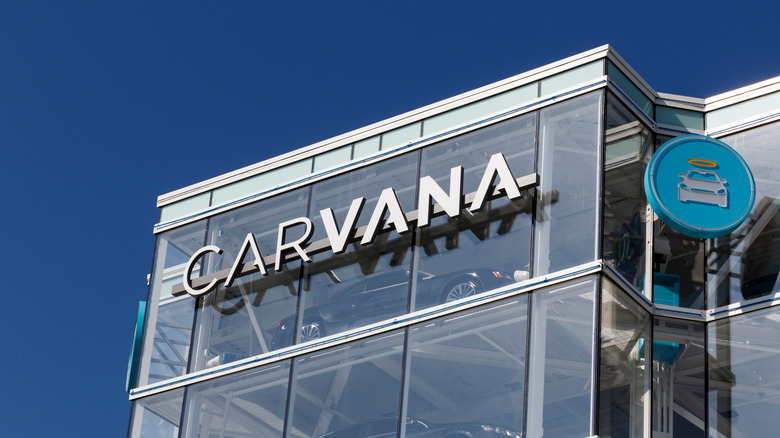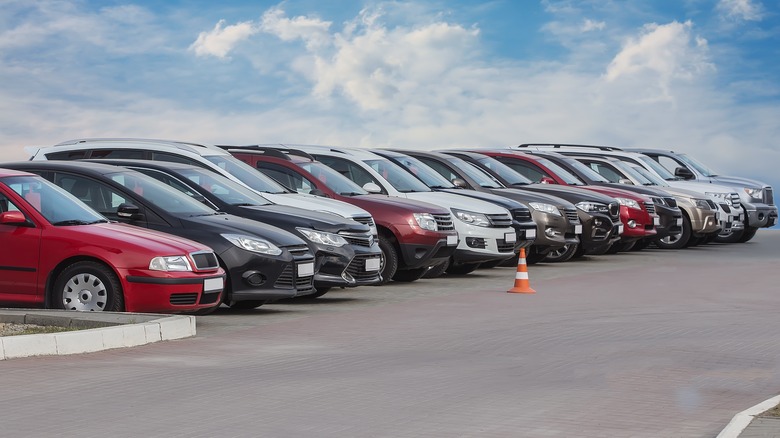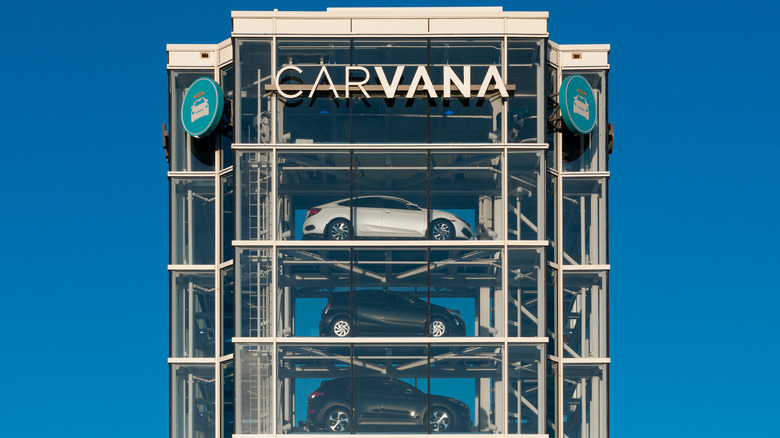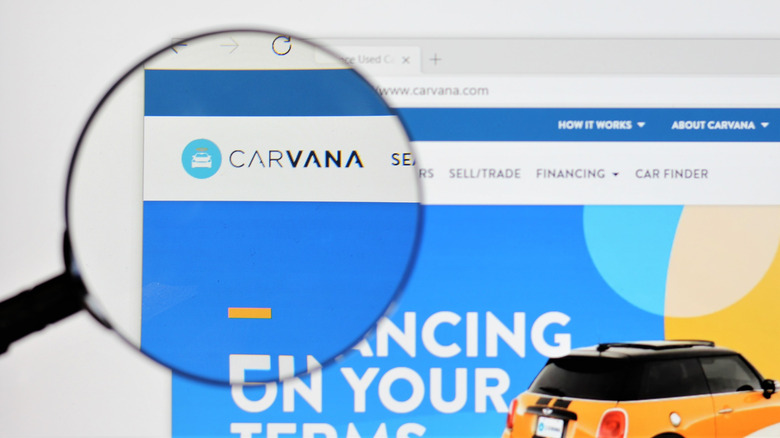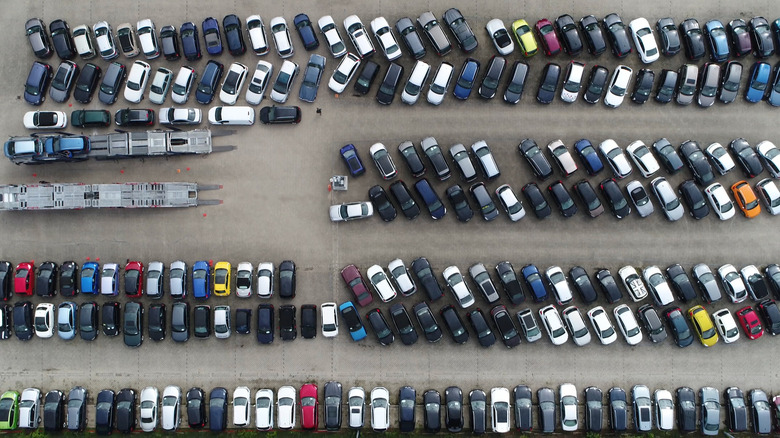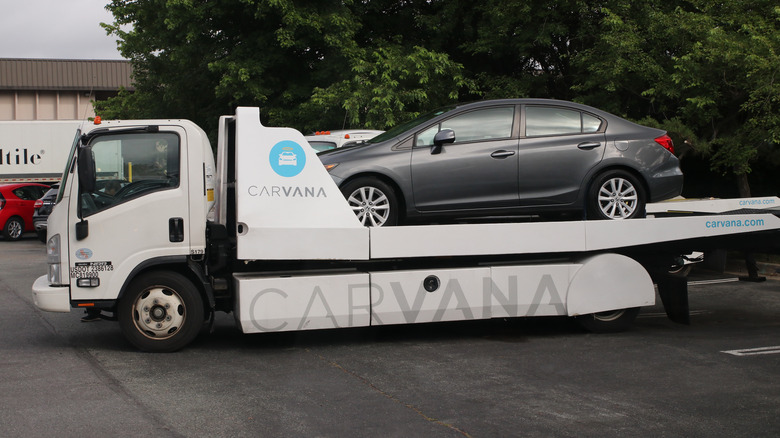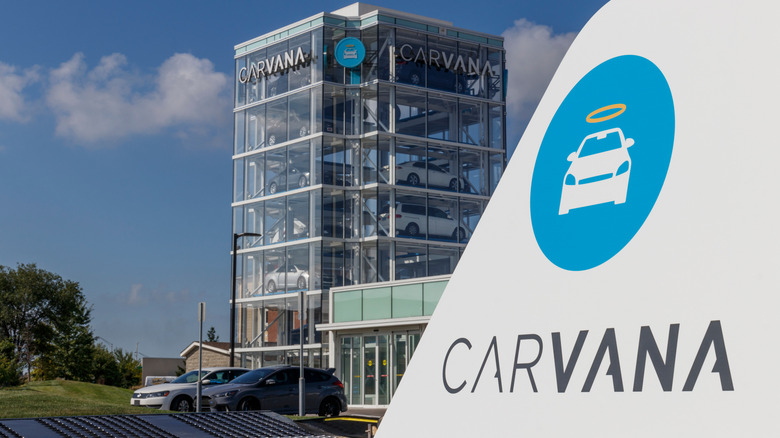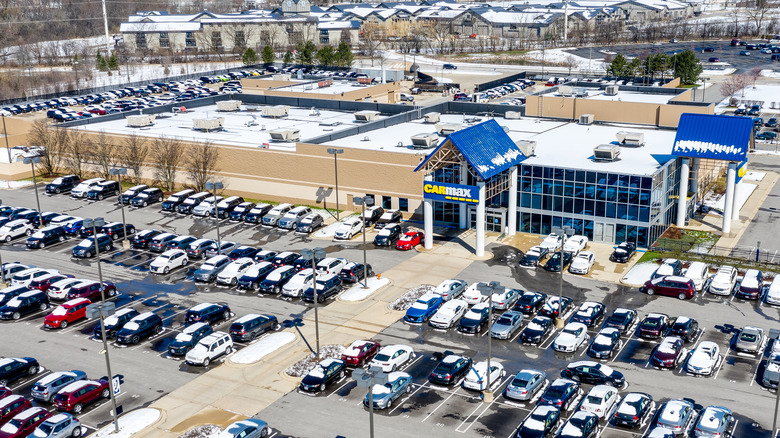Carvana: From Powerhouse To Flop
The Covid-19 pandemic might have wreaked havoc across countless industries and led to billions of dollars of losses for the U.S. economy, but there were a few companies that gained massively from the past few years of turmoil. Carvana was one of those companies, with its stock price reaching an all-time high of $360.98 per share in August 2021 (via Yahoo! Finance). However, just a year and a half later, Carvana's stock has collapsed over 98% from its peak and currently sits at under $5.00 at the time of writing. A brutal fall from grace, then, for a company that was at one point hailed as the "Amazon of used cars."
The blame for Carvana's fall can't be put down solely on the easing of pandemic restrictions, as the company made a number of poorly-timed investment choices that crippled its ability to continue being an innovator in the industry. With the supply of new cars no longer as badly affected by the global chip shortage, there are early signs that prices of used cars are beginning to correct from their pandemic highs. Carvana's large inventory, combined with the overheads it incurs as part of its unique business model, puts it at a significant disadvantage compared to traditional, location-based used car dealers. Only time will tell whether the company can survive or not, but let's take a closer look at what exactly went wrong for Carvana over the past year or so.
Origins
Carvana's origins can be traced back to DriveTime Automotive, the used car dealership chain that's owned by Ernest Garcia II. Garcia II's son, Ernest Garcia III, reportedly founded Carvana as a subsidiary of his father's company after graduating from university, and originally all of Carvana's inventory was bought directly from DriveTime. Garcia II also injected a significant amount of start-up capital directly into Carvana, amounting to around $100 million, according to Forbes. A few years later, Carvana was spun off to form a standalone company, no longer purchasing its stock from DriveTime.
Forbes notes that, although Garcia II provided a significant amount of the initial funding for the firm, and was also the biggest shareholder, he was not listed as a director or officer of the company when it was spun off. The report speculates that one of the reasons for this was due to Garcia II's previous conviction for bank fraud, relating to dealings with a previous company. Instead, it was Garcia III that became the CEO and the public face of Carvana. In 2017, the company debuted on the New York Stock Exchange, but this initial launch was far from perfect. After launching at $15.00 a share, the stock plunged to around $8.50 a share, at which point Garcia II reportedly bought a further 465,000 shares. His investment proved a shrewd one, as by the year's end, the stock was back to trading above the price of its initial offering.
Carvana's vending machines
Before the Covid pandemic catapulted Carvana to historic highs, it had already proved to be somewhat of a disruptor in the industry. One of its unique selling points was that, instead of picking up their car from a local dealership, buyers could use one of the company's eye-catching "vending machines." These vending machines were glass towers that were several stories high, with a selection of used cars that could be seen clearly from the outside. When a buyer finalized a purchase, they were given an oversized coin, which they could slot into a retrieval system. This system would then grab the car from its shelf in the vending machine and deliver it straight to the waiting customer in the collection bay.
From that point, the buyer would have seven days to inspect and test the car, to see if it was to their liking. If it wasn't, Carvana would accept the car back for a full refund. The first of these vending machines opened in Nashville, TN, but the company quickly opened more machines at locations across the country. To incentivize users to travel to one of these vending machines, Carvana offered up to $200 of flight credit and a taxi service from the airport for anyone who bought one of its cars (via Business Wire).
Growth through the pandemic
Carvana really hit its stride when the global chip shortage began to take effect in mid-2020. Just as workers were being forced to stay at home, driving up the demand for electronics, the first major wave of Covid had forced factories and supply chains to shut down. This had a knock-on effect on carmakers, as with supply chains suffering and their own factories being hit by Covid-related closures, they simply weren't able to produce enough vehicles to meet demand. As a result, demand for used cars skyrocketed, causing prices to spike. Carvana was the best-placed auto dealer to take advantage of this, as the company's entire buying process was already online, so there was no need to worry about Covid restrictions. Customers flocked to the company and in response, Carvana started to quickly expand its locations and inventory (via Modern Retail).
As revenue increased and more locations were opened, investors became increasingly bullish on the company's stock. Data from MarketWatch shows Carvana's share price increased from $111.00 at the start of June 2020 to $275.00 just a year later, eventually peaking in August 2021. However, things started to go downhill from there, with early signs beginning to show that there were some cracks in the company's growth plan.
Slowing sales
In the first quarter of 2022, Carvana reported its first decline in sales, with rising interest rates and falling used car prices causing some customers to hold off on their purchases. At the same time, the chip shortage was showing its first signs of easing, and car manufacturers began to increase production again. Neither second or third quarter sales figures were enough to assuage the fears of most investors, and all of the stock gains from the initial stages of the pandemic were quickly wiped out.
In addition to the number of car sales dropping, Carvana was faced with another problem: too much costly inventory. After buying cars from customers right at the peak of used car prices, Carvana was stuck with lots of inventory that it couldn't shift, at least not for a profit. While those vehicles were sitting unsold, they were also aging, exacerbating the problem. Being stuck with dealerships full of rapidly depreciating assets was bad enough, but by 2022, Carvana also faced more competition than it had done a year or two prior. More traditional dealerships had begun to move their buying process online, and the easing of pandemic restrictions meant that buyers were free to wander around used car lots again.
The problem with distance
A report from CNBC highlights an additional issue that Carvana faced compared to a traditional local car dealer: It had to transport its cars and customers all over the country. Although it had expanded its dealership network throughout 2020 and 2021, Carvana was still a long way from being easily accessible from every city. The company had offset this by offering its $200 flight credit, but this was an additional overhead that hurt profit margins. Buying cars from customers also required sending drivers to pick them up from various locations and drive them to one of Carvana's inspection centers, while purchased cars needed to be transported to the buyer's local vending machine for delivery.
In theory, a car could be bought off a customer by Carvana in one state, transported to another state for inspection, and then delivered to a third state for eventual delivery. Local car dealerships simply don't have these overheads to factor in, giving them a potential edge on pricing over Carvana.
Mounting debts
In an attempt to streamline its network and reduce its overheads, Carvana announced the purchase of the vehicle auction company ADESA U.S. in February 2022. This gave it ready access to wholesale stock and 56 new sites with which to process its used inventory, but left it $2.2 billion in debt. This was right as demand for used cars was beginning to slow down, and the questionable timing of the acquisition caused further concern for investors.
Losses were also beginning to pile up from the company's existing operations, and by the end of the third quarter of 2022, Carvana reported a $2.67 loss per share, bigger than analysts' expectations (via Reuters). Yet again, the stock shrank further, and some began to question whether the company could even survive with its mounting debt pile and shrinking revenue. The company had already laid off a portion of its workforce earlier in 2022 in an attempt to cut costs, and in November, it announced that a further 1,500 jobs would be cut. That represented 8% of its overall workforce, and stretched across several departments, including operations, technology, and corporate.
Survival and the future
Things aren't looking good for the once-prosperous company, with reports suggesting that Carvana might be bankrupt by the end of 2023 if it doesn't secure a significant infusion of cash (via CBT News). Even if it can solve its inventory issues and streamline its operations, the firm's debt pile from its acquisition of ADESA and various other loans means that its annual interest expenses alone are $600 million, according to CBT News. Investors might still also be wary of a company that can generate headlines such as, "[This] firm bought my car for more than I paid new ...," even if that purchase was in the middle of an unprecedented growth boom.
There is still a chance, of course, that an outside investor sees potential in the company, and provides the cash to keep it afloat while it attempts to return to profitability. There's also the possibility that Ernest Garcia II steps in with further financial assistance, or that his company DriveTime buys out part of Carvana's operation. Whatever happens, it seems like Carvana's stock presents a huge gamble for the investors that continue to hold out in the hopes of an eventual turnaround. CBT News quotes a Bank of America analyst as saying, "the performance of this stock appears binary. Either it goes to zero or it is worth many times its current [price]." For now, investors have no way of knowing which direction it will take.
Carvana's competition
If Carvana does go under, there are plenty of competitors waiting to take its market share. Vroom and Shift both work on similar business models to Carvana, although they've both had similarly disastrous stock price crashes and it's not clear whether either of them has enough funding to continue operating long-term. Copart, CarMax, and AutoNation are more traditional in their sales experiences, but they control a larger portion of the used car market than any of the three startups, and as a result, have much larger market caps.
That's not to mention the swathes of smaller, local car dealerships that continue to operate up and down the country, unaffected by the whims of Wall Street. Perhaps this is Carvana's biggest problem in the long term — now that pandemic restrictions are now (largely) a thing of the past, it has little to distinguish itself from its competitors ... well, apart from the car vending machines. As neat as they might be, they won't be enough to save Carvana from its billions of dollars of debt, overstocked inventory, and crucially, a stock market that doesn't believe it has what it takes to turn things around.
